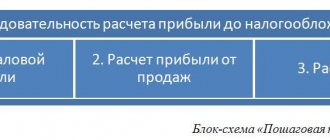Profit is one of the main indicators of a company's performance. The receipt or absence of profit characterizes the company’s activities as successful or unprofitable. The more profit, the better. This means that the enterprise works well, covers costs and, moreover, the entrepreneur who has made a profit can manage “free” money: direct it to the further development of the company or spend it on personal needs.
To determine profit, you need to know and be able to find related indicators such as costs (otherwise expenses or expenses) and revenue (income) of the company. People often don't see the difference between profit and revenue. In addition, profit is divided into types: balance sheet, net, taxable and others. In our article we will understand the intricacies of this most important indicator for every businessman.
Meaning
The indicator under consideration, among other things, characterizes the rational use of material and labor resources. In general, accounting profit is the difference between the income and expenses of an enterprise.
| Profit indicator | Explanation |
| Positive | Evidence that the company has received financial benefits from its activities |
| Income equals expenses | The break-even point has been reached: no profit or loss has been made |
| "Negative profit" | There shouldn't be such a thing. After all, when expenses exceed income, we cannot talk about any profit. |
Based on the value of the PWB, calculations are made to assess the effectiveness of the activity. For example, analysis is carried out in relation to material resources using various indicators. But the general one for them is profit per 1 ruble. material costs . The resulting coefficient is equal to the quotient of the extracted profit from the main activity (P) to the amount of material costs (MZ):
The growth of this value positively characterizes the activity of the enterprise. In practice, specialists conduct such analysis in more depth, using various factor models and establishing the reasons for changes.
Production costs
Considering the costs for the entire volume of output, the following production costs :
— constant (FC) - costs that do not depend on the volume of output (Q) and arise even when production has not yet begun. Thus, even before production begins, the enterprise should have at its disposal such factors as buildings, machines, and equipment. In the short term, fixed costs are rent, security costs, property taxes, etc.;
— variable (VC) - costs that change depending on the volume of output. These include: basic and auxiliary materials, workers' wages, transportation costs, electricity costs for production purposes, etc.;
— total (TC) – the sum of fixed and variable costs:
TC = FC + VC
[flat_ab id=”11"]
Variable and total production costs increase along with an increase in output, but the growth rate of these costs is not the same. Starting from scratch, as production increases, they initially grow very quickly, then as production volumes continue to increase, their growth rate slows down and they grow slower than production (positive economies of scale). Subsequently, however, when the law of diminishing returns comes into play, variable and total costs begin to outpace production growth.
Approach: How to Calculate Accounting Profit
According to the Regulations on accounting and reporting in the Russian Federation (Order of the Ministry of Finance No. 34-n, clause 79), the indicator under consideration is the final financial result for the reporting period. It is determined based on:
- accounting documents for all business transactions;
- balance sheet items.
Thus, all sources of income are summed up. And the formula for accounting profit looks like this:
PRb = D – Zav
Where: D – the company’s income for the period under review; Claims are obvious costs, which include labor costs, equipment purchases, utility bills, etc.
EXAMPLE 1
Based on accounting documents and the balance sheet, she received income in the amount of 10 million rubles in 2021. The table shows the costs associated with financial and economic activities. What will be the accounting profit ?
| Costs | Amount, rub. |
| Payment for bank services | 500 000 |
| Salary to employees | 6 000 000 |
| Communal payments | 1 500 000 |
| Other expenses | 900 000 |
Solution: 10,000,000 – 8,900,000 = 1,100,000 rubles.
EXAMPLE 2
Income for the past year amounted to 6.5 million rubles, and expenses were approximately the same 6.5 million rubles. What will be the accounting profit?
Solution: Since both indicators are equal, the activity brought neither profit nor loss to the organization.
Factors affecting profit
Thus, we can identify the main factors that influence increasing the profitability of an enterprise. They are divided into two types:
- Internal factors that influence the amount of profit by increasing the volume of products produced, selling them, improving them, increasing prices and reducing costs.
- External factors that do not depend on the operation of the enterprise and have virtually no effect on the amount of profit.
The first category, that is, internal factors, includes the following indicators:
- level of business activity;
- labor productivity at the enterprise;
- quality and competitiveness of products or services;
- professional qualities of managers and specialists;
- level of enterprise efficiency;
- planning and forecasting financial results.
The second category, external factors, includes:
- production factors showing the availability and use of labor and financial resources in production;
- non-production factors related to the sales and supply function, social conditions of work, and environmental measures.
Production factors are divided into two subtypes:
- extensive , which affect the extraction of profit in quantitative terms: financial resources, number of employees, equipment operating time, working time fund;
- intensive , affecting the profitability of the enterprise in qualitative terms:
– modernization of equipment and increase in its productivity;
– programs to increase capital turnover;
– increasing labor productivity by increasing the level of education of management and specialists;
– improvement of labor organization in production;
– reducing the labor intensity of products;
– effective application and use of financial resources.
External factors affecting increased profits:
- economic situation on the market;
- prices for purchased raw materials, materials for production;
- fuel and electricity prices;
- deductions for depreciation;
- state pricing policy, taxes, penalties and benefits provided under labor legislation;
- Natural resources.
In order to find out how the listed factors influence the gross profit of an enterprise, you need to understand what the cost of production is. The cost of a product, work or service is the valuation of all the costs that went into its production. This includes labor resources, raw materials and supplies, fixed assets and natural resources.
Note! When carrying out activities at an enterprise, external and internal factors are in close relationship with each other, and have a direct impact on the value of production costs, and therefore profits, revealing how rationally and economically material resources are used in the enterprise.
Types of accounting profit
It is customary to divide it depending on what revenues and/or costs are involved in the formation of the accounting profit .
| 1 | Gross | The amount of money received as a result of the sale of goods and services minus the costs of it: PRb = REVENUE - COST OF SALES |
| 2 | Profit (loss) from sales | Represents the difference between gross profit, selling and administrative costs |
| 3 | Profit (loss) before taxes | Sums up different indicators of types of income and subtracts expenses for them |
| 4 | Net income (loss) | The amount of money that remains after deducting all costs and taxes, fees, contributions |
Economic costs
Economic costs include both external and internal (including normal profit) costs, while accounting costs include only external ones.
Since the amount of accounting and economic production costs does not coincide, there are also differences in the amount of accounting and economic profit.
Net economic profit is equal to sales revenue minus the economic costs of production (external and internal, including normal profit).
The ability to change production methods and costs varies depending on how long it takes a firm to change production technology or respond to changes in market conditions. This fact is reflected in the existence of differences between production costs in the short and long term.
The short-run period is a period when most of the factors of production remain constant, fixed, and in order to increase (or reduce) the volume of production the firm can change only one factor of production. In the short term, such types of costs as buildings, equipment, and crop areas remain constant, so the company can influence production volume by changing only, for example, the number of employees hired.
In the long run, a firm can make changes to all factors of production. It can not only hire additional workers, but also expand its production capacity by building or purchasing additional premises and equipment, which will allow it to produce products on a scale that will best suit new market conditions.
When analyzing costs, it is necessary to distinguish between costs for the entire volume of output - total (total, total) production costs - and production costs per unit of output - average (unit) costs.
Reflection of the organization's profit in accounting
To determine this indicator, you need to be guided by information from synthetic accounting accounts.
Complete information on profit or loss for the reporting annual period is contained in account 99 “Profits and losses”. It is formed due to:
- receipt of revenue from sales (account 90);
- other income and expenses (account 91).
Such recommendations are contained in Order No. 94-n of the Ministry of Finance of 2000.
The “Profit and Loss” account also reflects various transactions every month throughout the year:
- financial receipts from sales or ordinary activities (Dt 90.9 – Kt 99);
- losses from sales or ordinary activities (Dt 99 – Kt 90.9), etc.
Also on account 99 are the amounts of accrued expenses (income) related to taxation, fulfillment of permanent obligations or tax sanctions. The correspondence goes to account 68 “Calculations for taxes and fees”.
At the end of the year, the received funds are transferred to account 84 “Retained earnings”. This is a kind of closing of accounts for the past period. The formula for accounting profit at the reporting date will look like this:
PRb = Balance 99 + Balance 84
Also see “How to keep accounting records in an LLC.”
Results
When profits are paid to the founders, employees of the organization or third-party citizens and organizations, it is written off to the accounts of settlements with recipients of funds.
When the profit is attributed to the increase in the reserve and authorized funds of the organization, it is written off to the capital accounts. And when profit remains in the organization’s turnover, its movement is recorded only in analytical accounting. You can find more complete information on the topic in ConsultantPlus. Free trial access to the system for 2 days.
Accounting and economic profit: what is the difference?
When analyzing business activities, experts often identify so-called lost profits and implicit costs. These include funds that could be obtained, for example, by using a different strategy or making a different management decision.
It is important to understand that accounting profit is a measure that excludes implicit costs.
Another value takes them into account - economic profit. It helps compare the desired profitability with the minimum required to meet all expectations and represents the difference between total income and all types of costs. Mathematically, the equation looks like this: Accounting profit = economic profit - implicit costs
When assessing efficiency, economic profit gives a complete picture of the use of enterprise assets, since it compares the actual result with rejected opportunities. A positive result indicates the rational use of resources. A negative or zero value may indicate a loss of funds from capital.
Also see “Retained earnings on the balance sheet, what is it?”
Read also
23.11.2018
Normal profit
Normal profit represents the minimum fee with which entrepreneurial ability must be rewarded in order to stimulate its use in a given firm, i.e. this is the minimum income that an entrepreneur must receive in order to remain in this business. This income should be no less than the profit that the entrepreneur could have in another, most profitable field of activity for himself, but is “lost” by him. Almost normal profit is determined by the entrepreneur himself as an assessment of alternative opportunities for applying his entrepreneurship.
Calculation of net profit of an enterprise
The business owner, shareholders, counterparties - for all of them, the economic performance of the company and profit, in particular, are important. The dynamics of key indices show what amount is at the disposal of the enterprise after deducting taxes and other mandatory payments.
Free cash (remaining after taxes and settlements with counterparties and shareholders) is a fund that can be used to develop and expand the business. Do not forget that profit also affects how much dividends interested parties will receive.
The formulas used to calculate key economic indicators were discussed earlier. However, there is another method for calculating the profit of an enterprise, which is based on accounting data.
Alternative calculation formulas:
- Addition of three types of profit - financial, gross, operating - and deduction of taxes.
- The amount of revenue is reduced by the amount of cost, expenses for administrative, commercial and other needs and the amount of tax payments.
- Tax payments are deducted from pre-tax profits.
These formulas are general. To get an accurate result, a corporate economist or accountant needs to adapt them to the company's activities, for example, adjust costs.
You may also be interested in: Profit maximization: the golden rule and methods of implementation
Methods for calculating future profits
Let us demonstrate how the planned profit of an enterprise is calculated.
- Direct counting method.
- Normative method.
- Extrapolation method.
- Analytical method.
It is calculated as the volume of planned revenue reduced by the amount of the full cost (including contributions to funds).
Profit generation based on a system of various standards, for example, for assets.
It is based on forecasting, that is, taking into account indicators of past periods.
The influence of various factors on the expected profit margin is taken into account: product sales volume, cost, selling prices, etc.
The results of the presented methods for calculating the profit of an enterprise depend on the direction of the company’s activities, the chosen strategy, and various external and internal circumstances.
Only a thorough analysis allows you to plan performance indicators, look for ways to optimize costs and ways to make your business more profitable.
Having decided on the amount of available funds, the entrepreneur should decide what to spend it on. You can not only scale up an existing business project, but also direct them to production or social needs:
- purchase new equipment to automate the technological process;
- introduce new technologies;
- make workers' working conditions safer;
- pay bonuses to staff or increase payroll;
- increase production capacity;
- use money for investment or invest in transactions with securities and currencies.
From all of the above, we can conclude that the enterprise needs to plan profits, and this task can only be accomplished through accurate accounting of all cash receipts and costs. Obviously, in order to achieve the maximum amount of available funds, the first ones need to be increased, and the second ones need to be optimized.
Let's imagine that a certain company engaged in the production of clothing received a negative profit at the end of the year. After analyzing current activities, the top manager came to the conclusion that the number of sewing machines should be reduced (based on the size of the forecasted figures) or replaced with new ones in order to reduce maintenance costs, but the control indicator for the volume of goods produced should be increased. All funds remaining after paying taxes and other payments will be used to implement the approved plan.
Calculation of enterprise profit using an example
Limited Liability Company "Cozy House", which is engaged in the production and sale of household goods, has the following financial statements at the end of two years (RUB):
| Index | Code | 2017 | 2018 |
| Revenue | 2110 | 130 000 | 70 000 |
| Technological cost | 2120 | 45 000 | 25 000 |
| Business expenses | 2210 | 6 000 | 4 000 |
| Management costs | 2220 | 18 000 | 13 000 |
| Other income | 2340 | 1 000 | 800 |
| Other expenses | 2350 | 2 000 | 3 000 |
| Percentage to be paid | 2330 | 6 000 | 4 000 |
| Income tax | 2410 | 12 000 | 5 960 |
- Calculation of marginal profit: PM = TR − VC.
2018 = 70 000 − 25 000 = 45 000.
2017 = 130 000 − 45 000 = 85 000.
- Calculation of gross profit: GP = TR − PC.
2018 = 70 000 − 25 000 = 45 000.
2017 = 130 000 − 45 000 = 85 000.
- Calculation of profit from sales: PS = TR − TC.
2018 = 70 000 − (25 000 + 4 000 + 13 000) = 28 000.
2017 = 130 000 − (45 000 + 6 000 + 18 000) = 61 000.
- Calculation of book profit: BP = PS − OI − OE.
2018 = 28 000 − 3 000 + 800 = 25 800.
2017 = 61 000 − 2 000 + 1 000 = 60 000.
- Calculation of operating profit: OP = BP + I.
2018 = 25 800 + 4 000 = 29 800.
2017 = 60 000 + 6 000 = 66 000.
- Calculation of net profit: NP = BP − T.
2018 = 29 800 − 29 800 × 0,2 = 23 840.
2017 = 60 000 − 60 000 × 0,2 = 48 000.
You may also be interested in: How to calculate sales profit and 55 ways to increase it
Table for calculating enterprise profit in Excel
Often businessmen have to independently calculate key economic indicators. To ensure accurate results, the process can be automated using special programs. Below is an example of calculating enterprise profit in an Excel table.
The table is divided into 4 blocks:
- Tax rates (profit, VAT) – cells B1:B2.
- Sales volume, costs and value added tax - cells B4:B6.
- Calculation of the VAT amount - cells B8:B9.
- Gross, net profit and calculation of corporate income tax - cells B11:B14.
The first two blocks are used to enter existing ready-made data; in the other two, the result is calculated automatically based on the entered formulas.
Excel formulas that can be used to calculate the amount of profit of an enterprise:
- Formula for calculating the amount of tax liability:
=ROUND(B4*(B1/(1+B1));2) – the result obtained is rounded to the second digit.
- Formula for calculating VAT payable to the budget:
=B8-B6.
- Formula for calculating gross profit excluding VAT:
=B4-B8.
- Formula for calculating the amount of gross profit:
=B11-B5.
- Formula for calculating corporate income tax:
=ROUND(B12*B2;2) – the result obtained is rounded to the second digit.
- Formula for calculating net profit:
=B12-B13.
The presented table can be adjusted to suit the characteristics of your enterprise, and it will become a useful working tool. Such programs are universal, regardless of external factors. So, if changes occur in tax legislation, then the calculation formula can simply be adjusted, let’s say replacing the base coefficient. If you change numbers, for example, sales revenue or costs, the results will be displayed in the corresponding cells.
A spreadsheet makes it possible to check your assumptions, evaluate how justified new investments or technologies will be, etc. Not a single large company can do without modern automation programs, such as Excel, since they are required for accounting, and for maintaining statistics, and for forecasting.
You may also be interested in: Sales return formula: calculation example








